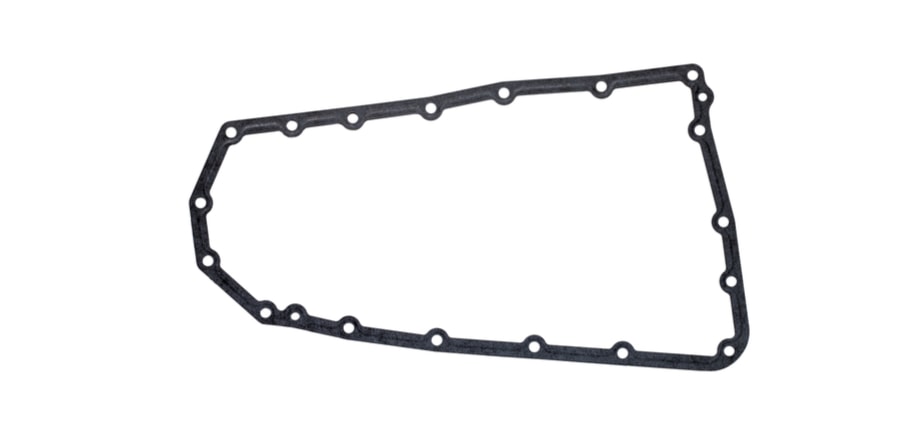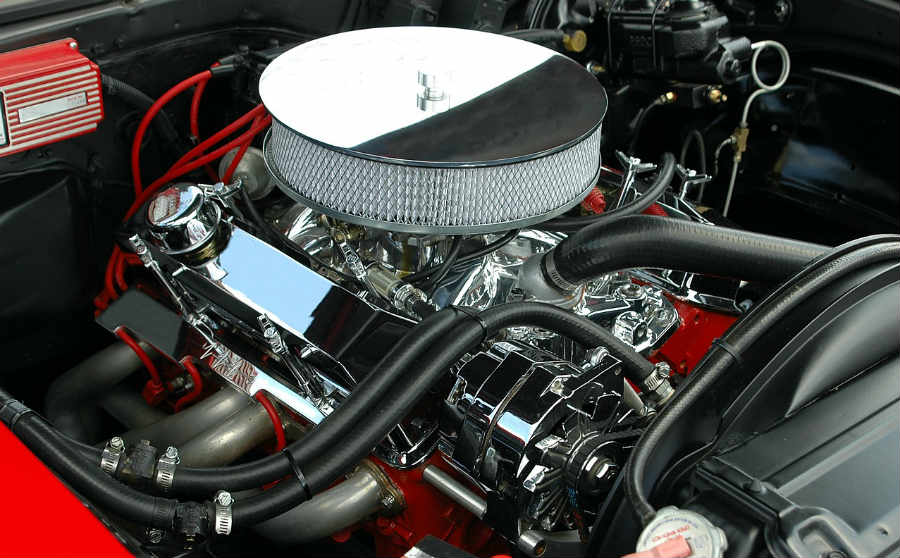All automotive engines use oil to keep the bearings and contact points lubricated. The oil also helps, to some degree, to cool down certain components inside the engine.
The oil pan is bolted to the underside of the engine block and is sealed against it with a gasket. The purpose of the pan is to hold the engine oil, both while the engine is running and when it is turned off. The pan must be large enough for all of the oil to be stored in it when the engine is not running but also accommodate a pickup tube running to the oil pump, which circulates the oil to various points when the engine is running.
Some oil pans today still use a gasket, but most modern vehicles use some form of RTV or form-in-place gasket (FIPG). If the gasket or mating surface is leaking, the oil pan will need to be removed and the sealant or gasket replaced, depending on the type of vehicle.
How Much Should an Oil Pan Gasket Cost?
The oil pan gasket replacement cost depends primarily on how hard it is to remove the oil pan, and that varies greatly between different engines and different vehicles. Most gaskets and liquid sealants are fairly inexpensive, so the bulk of the repair is the labor cost. As always, the labor rate is dependent on location. The cost of oil isn’t figured in, but most shops would charge for an oil and filter change on top of the oil pan gasket price, adding about $100 to the estimates.
Here are some examples, assuming a shop rate of $150 an hour:
- For a 2010 Ford Focus with a 2.0 liter engine, the job calls for 2.7 hours of labor. This oil pan uses a liquid gasket. The labor would cost around $405 for the service, and the gasket material should cost about $20, which makes the job cost about $425. If the oil pan is being replaced, a new OEM oil pan lists for $162, or an aftermarket one costs about $140, depending on markup.
- For a 2006 Honda Pilot with a 3.5 liter engine, the job calls for 6.2 hours of labor. This vehicle uses a liquid silicone gasket. The high labor on this vehicle is due to the difficulty in removing the pan, which requires the front subframe to be partially removed to gain access. The labor cost would be about $930, and the gasket material is about $25, which would make the job about $955. If the oil pan is also being replaced (which would be very common), an aftermarket oil pan costs about $120, or a new Honda oil pan lists for $220; this would make the total about $1075 to $1175.
- For a 2012 Chevrolet Camaro with a 3.6 liter engine, the book time is 10.8 hours; the high labor cost is due to the need to remove the front subframe to gain access to the oil pan. This oil pan uses a liquid gasket. The labor cost for the job comes to about $1,620, and the gasket material adds about $20, making the job total about $1645. If the oil pan is also being replaced, an OE pan lists for $811, or an aftermarket oil pan costs about $400, depending on markup.
- For a 2003 Ford Crown Victoria with a 4.6 liter engine, the labor time to replace the oil pan gasket is 6.6 hours. This engine uses a conventional molded rubber gasket. The labor would cost about $990, and a new gasket costs about $50, making the job about $1040 total. If the oil pan is also being replaced, either an aftermarket pan or an OE pan adds about $90 to the total cost.
What goes wrong with oil pan gaskets?

The main reason to replace an oil pan gasket would be a leak, and the main reason gaskets leak is simply age. Older cork, rubber, or neoprene gaskets weren’t always that good at sealing oil in the first place, and newer form-in-place gaskets tend to harden up with age and heat and begin to leak after ten years or so. It’s a pretty common issue, but it’s also most often not an emergency, as the oil held in the crankcase by the oil pan isn’t ordinarily under pressure. Most often, it will seep rather than drip.
If the PCV system isn’t working properly, however, that can cause oil leaks, including leaks at the oil pan, by trapping pressure in the crankcase. It’s not uncommon to replace the PCV valve along with any external oil leak repairs, just to be on the safe side. The PCV valve is generally an inexpensive part that is intended to be replaced on its own schedule.
Why Would You Need Your Oil Pan Replaced?

In the above oil pan gasket estimates, we included the price for oil pan replacement, as the labor is essentially identical. The oil pans on most older vehicles were formed of stamped steel, but most newer vehicles now use cast aluminum pans. Both have their advantages and disadvantages. Steel pans are less likely to be punctured by road debris than aluminum pans. On the other hand, steel pans are heavier and less rigid compared to aluminum pans.
The number one cause of oil pan replacement is stripped drain plug threads. This happens when the drain plug is overtightened, causing the threads to be stripped from the oil pan. Without proper threads, the drain plug cannot seal up tight.
This is most common on aluminum oil pans, though stamped steel oil pans can also be damaged. In most cases, the first try at repairing stripped threads would be to try an over-sized drain plug, but this generally isn’t a permanent repair. Another way to fix stripped threads is to install a “time-sert” repair, which basically involves enlarging and re-threading the existing drain plug hole, and then threading in a special spacer that is sized for the OE drain plug. This can be a permanent repair, especially on aluminum oil pans, but in many cases, the cost can come pretty close to a pan replacement.
The second most common cause of oil pan replacement is road debris puncturing the oil pan, as the oil pan is usually the lowest point of the engine. Aluminum pans can crack or shatter, while steel pans tend to bend. A bent oil pan can obstruct the internal oil pickup tube. Steel pans can also rust, which can eventually lead to leaks or weak spots, also requiring replacement.
FAQ’s
- How can I tell if my oil pan is leaking?
Usually, the best way is to keep an eye out for oil spots where you park your vehicle. If there are oil spots, inspecting the top and front of the engine should be done first, as any oil leak will tend to coat the bottom and back. If there are leaks above the oil pan, they should be addressed first, and then the engine should be cleaned and re-inspected. To confirm an oil pan leak, the vehicle usually needs to be lifted.
- How long should an oil pan gasket last?
A decent expectation, on average, might be ten years or 100,000 miles. There’s a lot of variety, of course, and a minor oil seep that’s not forming drips doesn’t necessarily need to be addressed at all.
- Can I drive with a leaking oil pan gasket?
It depends on how much it’s leaking. If drips are forming, those can blow back onto the exhaust system and cause a fire, so it could be a bad idea to drive for a long time. If an oil pan has a seepage that’s not affecting the oil level or coating any other components, that can be dangerous to drive with.
- Can I replace my own oil pan gasket?
In most cases, probably not. Many vehicles require special cradles to support the engine, which can only be done on a lift. There are a few that are relatively easy, but even those are much harder to do properly without having the vehicle up on a lift.
- What else should be looked at when replacing the oil pan gasket?
As the oil pan will be off, the threads on the drain plug should be inspected. If they appear worn or damaged at all, it would save time and money to replace the pan at that time.
- Do I need to change the oil when replacing the oil pan gasket?
It’s not absolutely necessary, but saving old oil to re-use generally isn’t done; there’s just to much opportunity to introduce contamination that could damage the engine. When the new oil is installed, the oil filter is usually replaced, so you can start from scratch on your oil change schedule.

Omg you’re a typical scumbag mechanic. Most cars will take no longer than an hour to remove and put back on! And $100 an hour for labour? What do u think you are? A brain surgeon! Gtf out of here u wanker!
It may be different in other countries, but it’s worth saying – in the US the mechanic typically has nothing to do with pricing. The amount of time charged for a job is almost universally based on “book time”, which is established by the vehicle manufacturers, or by Mitchell or Alldata. All of them do studies and test cases based on average techs doing actual repairs on actual vehicles. Any specific repair is likely to take more or less time, but on average it’s not a bad system. If a job pays an hour and takes a half hour, the customer is still charged an hour. If a job pays an hour and takes two hours, the customer is still charged an hour. What an oil pan job actually pays varies widely, but that’s out of any mechanic’s hands.
As far as the labor rate, that’s also very much out of the mechanic’s hands unless at an owner/operator shop. In the US those are definitely less common than large corporate chains or dealerships. Where I work our labor rate is $171 an hour now. The mechanics have no say in the matter, and their portion at the end of the day is relatively small.